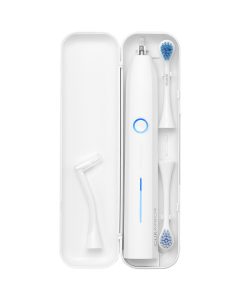The energy drinks epidemic – Dawn Woodward National Sales manager Curaprox UK
Featured Products Promotional FeaturesPosted by: Dental Design 4th April 2019

 Think back to your days as a student. You may remember having consumed a few energy drinks to help you stay awake during any long nights you spent preparing for exams, or completing an assignment. Caffeinated drinks remain a staple of a typical student’s diet, but many healthcare professionals are worried that an energy drinks epidemic could be having a detrimental impact on the general and oral health of young people in the UK.[i]
Think back to your days as a student. You may remember having consumed a few energy drinks to help you stay awake during any long nights you spent preparing for exams, or completing an assignment. Caffeinated drinks remain a staple of a typical student’s diet, but many healthcare professionals are worried that an energy drinks epidemic could be having a detrimental impact on the general and oral health of young people in the UK.[i]
In 2014, researchers from the World Health Organisation (WHO) warned that energy drinks could pose a substantial threat to public health, particularly among children and adolescents.[ii]Since then, the UK government has faced considerable pressure to introduce strict regulations on the sale of energy drinks to children. Concerns only increased following the death of 25-year-old Justin Bartholomew, who was known to consume 15 energy drinks a day. His family believe that his addiction to energy drinks had a negative effect on his mental health, which led to Justin committing suicide in 2017.[iii]Although government advisors have now concluded that there is insufficient evidence to warrant a ban on selling energy drinks to under-18s, many experts remain adamant that the products could be particularly damaging for young people.
What is an energy drink?
An “energy drink” is generally referred to as a non-alcoholic beverage that contains caffeine, taurine (an amino acid), sugar and B vitamins, in addition to other plant-based ingredients like ginseng and guarana.[iv]Energy drinks were originally introduced to consumers in Japan as a medicinal tonic designed to boost energy, but they became increasingly popular in Europe during the 1980s and 1990s – possibly due to the rise of rave culture.[v]Available in eye-catching, vibrant and colourful cans, energy drinks have been widely promoted as a stimulant that helps increase energy, enhance mental alertness and improve physical performance. This is arguably one of several reasons why some well-known energy drink brands – including Red Bull, Monster and Rockstar – have marketed their products through extreme sports-related sponsorship deals and celebrity endorsements.
The global energy drinks market value is expected to reach approximately £55.8 billion by 2024.[vi]In Europe alone, it is estimated that 30% of adults and 68% of adolescents regularly consume energy drinks, which are frequently mixed with alcohol to ensure a “boost of energy” on a night out.iTaste, brand loyalty and perceived positive effects combine to ensure the popularity of energy drinks among young people.[vii],[viii]According to the latest report from the European Food Safety Authority, UK adolescents are now among the highest consumers of energy drinks in Europe.[ix]With so many of the youngest in our society consuming energy drinks by the litre every day, more research is required to confirm the short- and long-term effects of energy drinks on a child’s health, behaviour and education.
Does it really give you wings?
While they are not all created equal, there are two ingredients that remain key to most energy drink formulas: caffeine and sugar. A simple search online reveals that the quantity of caffeine – a well-known stimulant – in a typical can (16 fl. oz.) of energy drink can range from 50mg to 500mg. To put it into perspective, the caffeine content of an energy drink can be an estimated 470% of that in a can of Coca Cola (32mg in 12 fl. oz.) and 160% of that in a cup of coffee (95mg in 8 fl. oz.). Consuming caffeine to excess can cause a wide range of cardiovascular problems, including heart palpitations and an increase in blood pressure.[x]Many people still do not realise that caffeine is also a highly addictive substance, which can have devastating effects on an individual’s mental health – increasing their risk of experiencing stress, anxiety, depression, and insomnia.[xi]
The high levels of sugar contained in most popular energy drinks are also a cause for concern. One study has found that the average sugar content in a typical energy drink is more than the entire daily recommended sugar intake for an adult in the UK.[xii]As practitioners are aware, consuming energy drinks that are high in sugar can contribute to the development of obesity, various types of cancer, and chronic diseases such as type 2 diabetes, which is costing the NHS approximately £10 billion each year.[xiii],[xiv]The acidic substances contained in most energy drinks – combined with a high sugar content – can also result in increased risk of enamel erosion and dental caries, which could eventually lead to tooth loss unless effective oral hygiene is implemented.[xv],[xvi]
Safeguarding general and oral health
Consuming energy drinks in moderation – if at all – is vital to safeguarding our general health. Good oral hygiene is also important to ensure teeth and gums are protected against the harmful effects of energy drinks. Practitioners can recommend the Hydrosonic Ortho toothbrush from Curaprox to help patients optimise their oral hygiene, which is ideal for some young people who may be undergoing orthodontic treatment. This innovative device boasts cutting-edge Swiss brush head technology that enables patients to gently and effectively clean between teeth and along the gingival margin, ensuring thorough removal of bacteria and plaque.
Energy drinks will continue to grow in popularity over the next few years. So long as patients maintain a sensible attitude towards the consumption of these caffeinated beverages, they can prevent future complications from arising.
For more information please call 01480 862084, email info@curaprox.co.ukor visit www.curaprox.co.uk

References
[i]Seifert, S. M., Schaechter, J. L., Hershorin, E. R. and Lipshultz, S. E. (2011) Health Effects of Energy Drinks on Children, Adolescents, and Young Adults. Pediagtrics. 127: 511-528. Link: http://pediatrics.aappublications.org/content/pediatrics/127/3/511.full.pdf. [Last accessed: 17.01.19].
[ii]World Health Organisation. (2014) Energy drinks cause concern for health of young people. Link: http://www.euro.who.int/en/health-topics/disease-prevention/nutrition/news/news/2014/10/energy-drinks-cause-concern-for-health-of-young-people. [Last accessed: 17.01.19].
[iii]BBC. (2018) MP calls for ban on high-caffeine energy drinks. Link: https://www.bbc.co.uk/news/uk-politics-42633277. [Last accessed: 17.01.19].
[iv]Leaf, A. (2018) Are energy drinks bad for you? Link: https://examine.com/nutrition/are-energy-drinks-bad-for-you/. [Last accessed: 17.01.19].
[v]NHS. (2014) Warnings issued over energy drinks. Link: https://www.nhs.uk/news/food-and-diet/warnings-issued-over-energy-drinks/. [Last accessed: 17.01.19].
[vi]PR Newswire. (2018) The Global Energy Drink Market size is expected to reach $72 billion by 2024, rising at a market growth of 7.1% CAGR during the forecast period. Link: https://www.prnewswire.com/news-releases/the-global-energy-drink-market-size-is-expected-to-reach-72-billion-by-2024–rising-at-a-market-growth-of-7-1-cagr-during-the-forecast-period-300733152.html. [Last accessed: 17.01.19].
[vii]Visram, S., Cheetham, M., Riby, D. M., Crossley, S. J. and Lake, A. A. (2016) Consumption of energy drinks by children and young people: a rapid review examining evidence of physical effects and consumer attitudes. BMJ Open. 6: e010380. doi: 10.1136/bmjopen-2015-010380. Link: https://bmjopen.bmj.com/content/6/10/e010380.info. [Last accessed: 17.01.19].
[ix]European Food Safety Authority. (2013) “Energy” drinks report. Link: https://www.efsa.europa.eu/en/press/news/130306. [Last accessed: 17.01.19].
[x]Ellis, M. (2013) Energy drinks alter heart function, study shows. Medical News Today. Link: https://www.medicalnewstoday.com/articles/269569.php. [Last accessed: 17.01.19].
[xi]Richards, G. and Smith, A. P. (2016) A Review of Energy Drinks and Mental Health, with a Focus on Stress, Anxiety and Depression. Journal of Caffeine Research. 6(2): 49-63. doi: 10.1089/jcr.2015.0033. Link: https://www.liebertpub.com/doi/pdf/10.1089/jcr.2015.0033. [Last accessed: 17.01.19].
[xii]Hashem, K. M., He, F. J. and MacGregor, G. A. (2018) Cross-sectional surveys of the amount of sugar, energy and caffeine in sugar-sweetened drinks marketed and consumed as energy drinks in the UK between 2015 and 2017: monitoring reformulation progress. BMJ Open. 7: e018136. doi: 10.1136/bmjopen-2017-018136. Link: https://bmjopen.bmj.com/content/7/12/e018136.info. [Last accessed: 17.01.19].
[xiii]Malik, V. S., Popkin, B. M., Bray, G. A., Després, J-P. and Hu, F. B. (2010) Sugar-Sweetened Beverages, Obesity, Type 2 Diabetes Mellitus, and Cardiovascular Disease Risk. Circulation. 121: 1356-1364. doi: 10.1161/circulationha.109.876185. Link: https://www.ahajournals.org/doi/pdf/10.1161/circulationaha.109.876185. [Last accessed: 17.01.19].
[xiv]Diabetes UK. (2014) The Cost of Diabetes Report. Link: https://www.diabetes.org.uk/resources-s3/2017-11/diabetes%20uk%20cost%20of%20diabetes%20report.pdf. [Last accessed: 17.01.19].
[xv]Jeong, M-J. et. al. (2014) A Study on the Enamel Erosion Cause by Energy Drinks. J Dent Hyg Sci. 14(4): 597-609. Link: https://touroscholar.touro.edu/cgi/viewcontent.cgi?article=1007&context=sjlcas. [Last accessed: 17.01.19].
[xvi]Kaye, G. (2017) The Effects of Sports Drinks on Teeth. The Science Journal of the Lander College of Arts and Sciences. 10(2): 52-55. Link: https://touroscholar.touro.edu/cgi/viewcontent.cgi?article=1007&context=sjlcas. [Last accessed: 17.01.19].
No Comments
No comments yet.
Sorry, the comment form is closed at this time.



